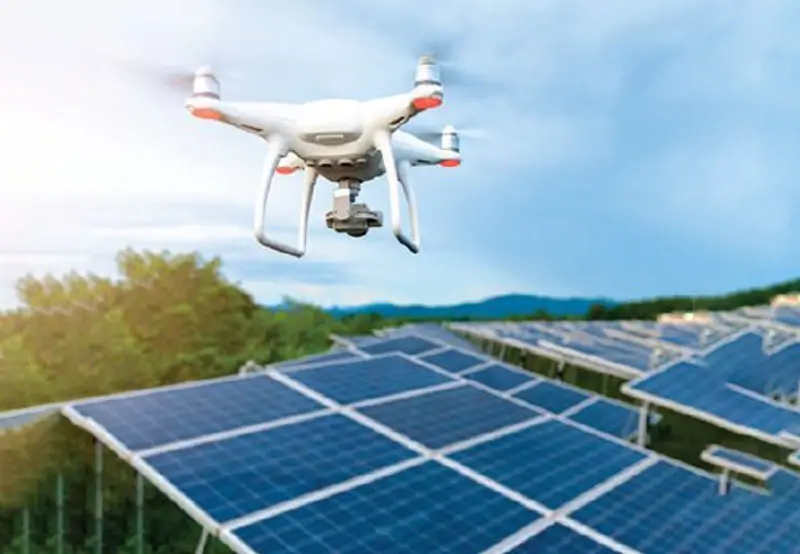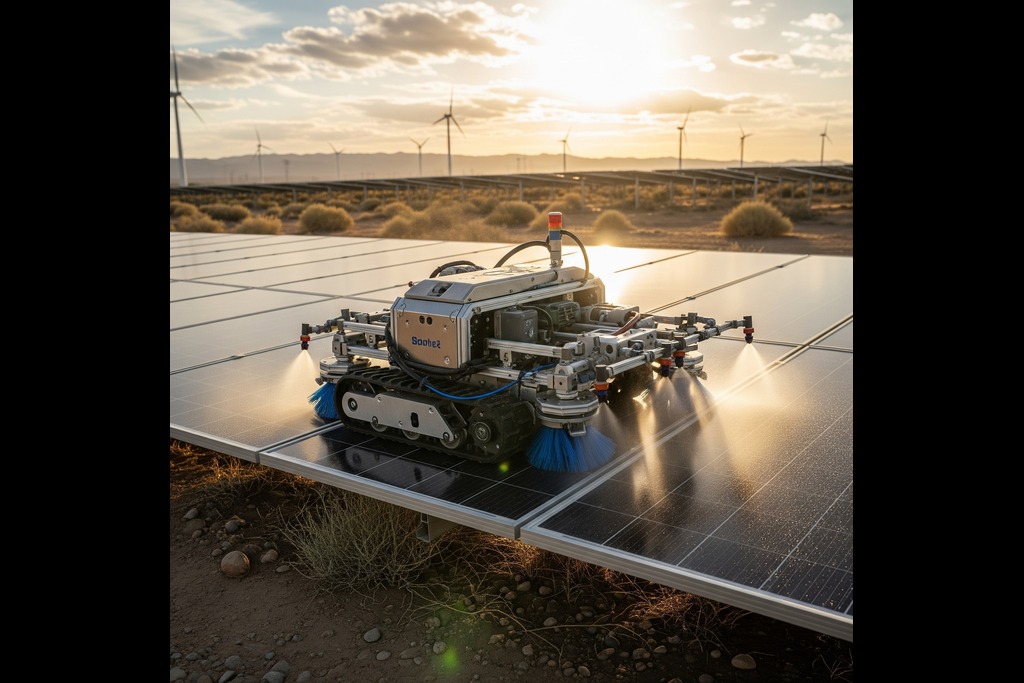Introduction
The solar power sector is changing fast, and technology is contributing greatly to maximizing efficiency, cutting down on operations cost, and increasing power production. Among the biggest changes revolutionizing solar operations and maintenance (O&M) are the incorporation of solar robots, solar panel cleaning drones, and IoT in the solar sector. These innovative technologies are disrupting solar farm operations, maximizing performance while reducing the need for human intervention and operating downtime.

Solar panel maintenance is important to achieve maximum energy production. Dust, dirt, and environmental debris can dramatically slow down efficiency, causing low power output. Manual cleaning through conventional methods is not only time-consuming but also labor-intensive and expensive. Here is where solar cleaning drones and solar panel cleaning robots are introduced. These autonomous systems guarantee effective, affordable, and environmentally friendly ways of maintaining clean solar panels and keeping them running.
Here in this blog, we discuss how robotics, drones, and IoT are transforming the future of solar O&M, increasing efficiency, lowering costs, and making sustainability a reality. We will talk about the newest developments, their advantages, and how they are affecting the renewable sector.
The Role of Robotics in Solar O&M
1. Solar Cleaning Robots: A Game Changer
Solar cleaning robots are autonomous or semi-autonomous machines designed to clean solar panels without requiring water or manual labor. Their smart brushless technology, vacuum system, and automation are based on AI and eliminate dirt and trash efficiently.
Key Benefits:
- Waterless Cleaning: Most solar robots use dry-cleaning mechanisms, making them ideal for arid regions where water conservation is critical.
- Robots are Automated: These robots run on the set schedules and thus edifies regular maintenance without human interference.
- Better Energy Production: Routine cleaning of panels will give it a better production yield.
- Cost Savings: Less expenses spent on labor force and manual cleaning teams.
2. Solar Panel Cleaning Drones: Aerial Efficiency
Another breakthrough technology in solar O&M is the use of solar panel cleaning drones. Such drones have dedicated cleaning mechanics like a misting system, rotary brushes, high pressure air blower, to effectively remove the dust and debris on solar panels.
Key Benefits:
- Increased Speed: Compared to a manual technique, drones can be used to clean large solar farms at a higher rate.
- Remote Control: It can be controlled by software to facilitate fewer staff on-site.
- Minimal Panel Contact: Decreases physical contact between the panel and glass hence minimising the risk of panel damage through physical contacts.
- Reaching Hard-To-Reach Areas: Perfect location to hold rooftop solar system and solar farm.
IoT in Solar Energy: Smart Monitoring & Predictive Maintenance
The integration of IoT in solar energy is another revolutionary step towards enhanced solar O&M. IoT-based systems use sensors, AI algorithms, and cloud computing to monitor and analyze the performance of solar panels in real time.
How IoT is Transforming Solar O&M:
- Real-Time Monitoring: The power output, temperatures, dust build up and possible failures are monitored via sensors.
- Predictive Maintenance: The AI-based insights can be used to predict maintenance requirements and avoid the problem of down time.
- Remote Diagnostics: Enables the operators to detect and correct problems remotely; this saves time and cut costs.
- Data-Driven decision making: Analytics on IoT platforms would maximise solar energy generation.
The combination of solar robots, solar panel cleaning drones, and IoT in solar energy is setting new benchmarks in renewable energy O&M, making solar power more reliable and efficient than ever before.
Conclusion
The solar O&M future is being redefined by robotics, drones, and IoT. Solar panel cleaning drones and solar cleaning robots are increasing the efficiency, cost-effectiveness, and sustainability of solar energy maintenance. On the other hand, IoT in solar power is facilitating smart monitoring and predictive maintenance for maximum energy production.
With increasing demand for renewable energy, investment in these emerging technologies is not just going to enhance efficiency of operations but also lead towards a greener and sustainable tomorrow. The use of AI, robotics, and IoT in solar maintenance is the way to unlock the true potential of solar energy and render it more dependable and accessible for a cleaner tomorrow.
Frequently Asked Questions (FAQs)
Solar robots use automated systems, sensors, and AI algorithms to clean solar panels efficiently. They can operate on pre-set schedules and often require minimal human intervention.
Yes, solar panel cleaning drones are designed to minimize direct contact with panels. They use non-invasive cleaning methods such as misting, high-pressure air, or soft brushes to remove dust without causing damage.
The cost varies depending on the size of the solar farm, the type of robots used, and the level of automation required. However, long-term savings on labor and maintenance make them a cost-effective investment.
IoT-enabled systems provide real-time monitoring, predictive maintenance, and data analytics to optimize solar power generation, reducing downtime and improving efficiency.
While drones are highly effective for cleaning, they are often used alongside ground-based solar robots for comprehensive maintenance, especially in large-scale solar farms.












